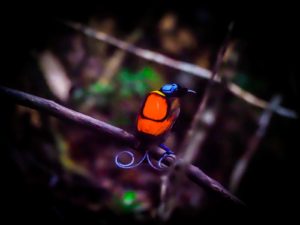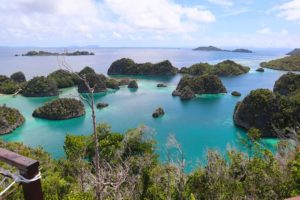Raja Ampat is considered an epicentre of marine biodiversity – and here at Raja Ampat Biodiversity Resort, we sit right in the middle of the action! With over 550 corals species (nearly up to 75% of all species that exist in the world), around 700 kinds of molluscs and 1,711 species of fish and 17 species of whales and dolphins, it’s no wonder we are considered to have some of the best diving in the world right here on our doorstep.
Raja Ampat offers one of few marine environments in which you can see the full range of marine fish, from sharks, manta rays, batfish, groupers, pygmy seahorse or schooling jacks, bannerfish and barracudas, pale-tailed surgeonfish and large six-banded angelfish, purple and threadfin anthias add to the spectrum of colour! Hidden in the cracks and crevices of the reef are banded pipefish, and even giant morays. You will wish your log-book pages were longer!
But there are so many spots, where do you start?! With over 25 dive sites in on our doorstep at Raja Ampat Biodiversity, we have something to suit everyone’s ability and taste – but we still have our favourites!
Starting at number 5, here’s our run down of the top 5 Raja Ampat dives sites in the Dampier Straight – make sure you don’t miss them next time you’re in Raja Ampat.
But there are so many spots, where do you start? With over 25 dive sites on our doorstep of our Biodiversity Eco Resort, we have something to suit everyone’s ability and taste, but we still have our favourites!
Starting at number 5, here’s our rundown of the top 5 dives sites in the Dampier Straight – make sure you don’t miss them next time you’re in Raja Ampat.
5. MANTA SANDY – THE BALLET

Level: Beginner
Depth: 5-18m
Current: Mild to Strong
Photography: Wide Angle
Between the months of October and April, mantas gather in large numbers to feed in the plankton rich waters of the Dampier Straight. They have preferred “cleaning stations” where they briefly stop and allow cleaner wrasses to pick off any parasites they accumulated during their long migrations.
Manta Sandy isn’t a conventionally rich dive as it doesn’t offer you to scope of life you can see at other sites whilst diving Raja Ampat. However, when you strike it lucky here, it’s pure gold. On a good day it might look like the runway of a busy airport as up to 20 Mantas somersault and play around in these cleaner stations leaving divers in awe of these enormous creatures.
We have a strict policy of adherence to not approach them too closely as they spook very easy and will leave the area not returning for very long periods – if ever. Divers stay behind a pre-determined line allows us to spend up to an hour seeing these graceful giants circling back and forth. Bliss!
4. MIKE’S POINT – THE EXCITING ONE

Level: Intermediate to Advanced
Depth: 3-30m
Current: Strong
Photography: Wide Angle and Macro
Hold onto your regulator guys – you could be in for an exhilarating ride when you roll back into the waters over Mike’s Point. Mikes is known to have some of the strongest currents in Raja Ampat! But if you’re prepared to brave it, what it offers is something both unique, and true to all that diving here in the Dampier Straight has to offer.
Looking like a Japanese Warship from the air, the US Air Force repeatedly bombed the island during WWII. In the intervening years, the reef has recovered remarkably with the chunks of rocks being blown off creating magnificent crevices and overhangs for an array of macro subjects.
Ascending on a huge wall there is usually a group of Sweetlips smiling for the cameras. As the site sits almost smack in the middle of the Dampier Strait you can regularly spot hunting Spanish Mackerel or cruising White Tip Reef and Black Tip Reef Sharks. As you spend the latter half of the dive in the shallows be on the lookout for Wobbegong and Epaulette Sharks, Turtles and Sea Snakes.
3. BLUE MAGIC – ANOTHER WORLD

Level: Advanced
Depth: 10-30m
Current: Strong
Photography: Wide Angle and Macro
Sitting in the middle of “blue” ocean, the ever-present anticipation of what is just beyond sight makes this spot true “magic”. Allow a swell of joyful expectation flood your body as your descent onto this submerged reef. Great schools of fish swarm around the mostly hard corals and a few soft corals, relentlessly being pursued by big numbers of Spanish Mackerel, Giant Trevally, Barracuda, Dogtooth Tuna, Rainbow Runners and countless Jacks.
And don’t forget to look out into the blue! The Blacktip Reef and Grey Reef Sharks, Bumphead Parrots and even huge oceanic Manta’s will sneak up on you when you’re not looking. This is the one site where anything can happen… and it usually does!
2. SARDINES REEF – THE RUSH HOUR

Level: Intermediate to Advanced
Depth: 5-30m
Current: Strong
Photography: Wide Angle and Macro
An oval shaped reef patch, Sardine Reef sits right in the middle of some open ocean. But divers don’t come here looking for schooling Sardines, they come looking for schooling everything else! The fish here are packed like sardines all over the reef. Look out for big teams of Fusiliers, Surgeonfish, Snappers, Damselfish and Butterflyfish taking shelter on this beautiful underwater mound.
All this food attracts predators such as Barracuda, Spanish Mackerel, Giant Trevallies and several types of Jacks. Sometimes you might even find some Grey Reef Sharks on the hunt. This is also a great site to spot some less common species like Oceanic Triggerfish, Bumphead Parrotfish and Napolean Wrasse.
1. CAPE KRI – THE BIODIVERSITY

Cape Kri
Level: Intermediate to Advanced
Depth: 5-25m
Current: Mild to Strong
Photography: Wide Angle and Macro
At number 1, the site that gave us our cherished name – Biodiversity! Cape Kri is perhaps the most famous of Raja Ampat dive sites due to the record breaking 283 species (and growing) recorded in a single dive!
The corner of the Cape offers divers a kicking current that will give even the most experienced divers a rush of blood with the scintillating prospect of a Manta and Eagle Ray flying by.
Further along the site the steep slope has absolutely everything on offer. The coral fields play host to an accent of colour provided by swarms of Fusiliers, Damsels, Surgeons and Anthias. Dogtooth Tuna, Barracuda, Mackerel, Trevallies as well as Grey Reef, Blacktip Reef and White Tip Reef Sharks are frequently seen patrolling the area. You might also be surprised by Bumphead Parrots, Napoleon Wrasse and some very big groupers.
This site is every bit the sensory overload and will continue to mesmerize even after multiple dives.
If you’d like to know more about any of our local Raja Ampat dive sites or how you can sign up for your Raja Ampat Dive Package, join us on these thrilling dives, please drop us a line at info@rajaampatbiodiversity.com




































